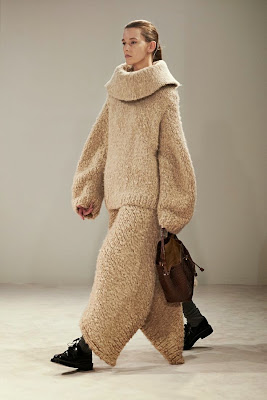The Interweave Knits Fall 2014 issue is out! Let's have a look at it.
This is the Ropemaker Pullover. It's the kind of "classic with a twist" design that most appeals to me. It's wearable and yet there's something new and interesting about it, the twist in this particular case being the angled bottom of the front cabled panel that is a very clever way to incorporate pockets.
The Hitch Pullover. The overall design of this is fine, but the cropped sleeve length and the placket that is probably not designed to button in front make make the sweater look too small rather than looking like deliberate design decisions.
The Polo Pullover. I like this one on the whole, but am not sure about that broken rib yoke. I think maybe it needs a strip of some other contrasting stitchwork along the bottom to make it look finished off, rather than just stopping randomly as it does.
The Redfern Cardigan. Very much like this one. It's got quite lot of interesting detail and is totally wearable for daily life.
The Bee Stitch Cardigan. This says "depressed and frumpy sixties housewife" to me. It's shapeless and unfinished-looking.
The Zipper Cowl. The graphic design of this is very attractive, but the shape is perhaps not quite working. Cowls do have a certain unfortunate tendency to get that "flat tire hung around the neck" look. I'd maybe scale this one down a little.
The Wheaten Pullover. This isn't bad, but it is a tad on the boxy and sloppy side. I'd raise the dropped shoulders and add a little waist shaping.


The Meadow Tunic. I like this one although I am not sure about the built-in sleeveless glove gimmick on the cuffs. I'm assuming the half-gloves will fold back to look like cuffs, which will be useful should the wearer want to, say, eat a sandwich or use the toilet, but I do have other concerns. I know I've previously praised a jacket design that had attached fingerless gloves, but that was a jacket. This sweater looks meant for indoor wear and it doesn't make much sense to wear gloves all day long when you're indoors, unless you're the type who is always cold, but even then the gloves give the item a depressive look. This sweater looks like part of Sandra Bullock's wardrobe from While You Were Sleeping, in which she plays a dispirited forlorn type who always wears her sweater sleeves down to her knuckles and sits around eating cookies she's dipped into her cat's milk bowl. Which had a certain charm, but we all wanted her to move on from that, right?
The Tandem Scarf is convertible: it can be worn as a cowl as you see here or, when unbuttoned, as a scarf. It's a clever idea, and I love the intricate cables used here. I'm not sure the secondary colour adds anything, though. I would probably do this one in a single colour.


The Saddleback Cardigan. Classic beautifully detailed piece. Nothing to criticize here.
The Whitewood Beret and Mittens. Lovely cabled tam and fingerless mitts set.
The Tugboater Pullover is an attractive man's sweater. As a Torontonian, all I can think of is it looks like an adult, unobtrusive version of a Maple Leafs hockey sweater. Strangely though for a team that hasn't brought home the Stanley Cup in most of its fanbase's lifetime, its fans usually have little interest in being unobtrusive.
The Blush Cardigan. I don't care for this one, though I think it would look much better if it had been styled differently. Worn over an empire-waisted dress, or one without seams in the front, it would be much more attractive. One of the biggest problems with these cropped length cardigans is that they chop the figure up visually by creating too many horizontal lines in a way that isn't flattering to any woman. About the sweater itself, I do like the detailing around the neck, and the beautiful yarn used. The bottom hem and cuffs have been left looking a little too plain and unfinished looking.
The Erstwhile Scarf. This is another "convertible" cowl/scarf with buttons. It's quite lovely, with great texture, and it lies so well as a cowl. No flat tire here.
The Rock Quarry Stole is quite a nice piece. The linen stitch and bobbled edge are an interesting new combination.
The Milkweed Shawl is a lovely little item. It will be useful either as a shawl and as a scarf.
The Fiddlesticks Cowl. The copy for this design says it "uses a twisted stitch found in traditional Austrian and Bavarian knits. Twisted stitches are essentially mini-cables, giving the fabric the textural interest of cabling without the cable needle." Interesting, because I had initially thought this was cabled. Nice piece with great texture.
The Roosevelt Cardigan. Another lovely classic cardigan. As in the Ropemaker Pullover above, the pockets are ingeniously integrated into the cable design.
The Black Baccara Cardigan. This is a very decent piece of work overall, but I think the neckline detracts. It looks unfinished and even a little ragged.
The Climbing Rose Henley. I love the concept of a henley with pretty, feminine touches, but not quite sure I care for the execution. The roses are lovely, but I'm not sure the contrast colour used at the neckline, cuffs, and waistband is quite the best direction to go here. I think I might do the piping and the ruffled neckline band in the rose colour, do the waistband and cuffs in the main colour, and omit the ruffles at the wrists.
The Archway Hat. Nice little cap.














































